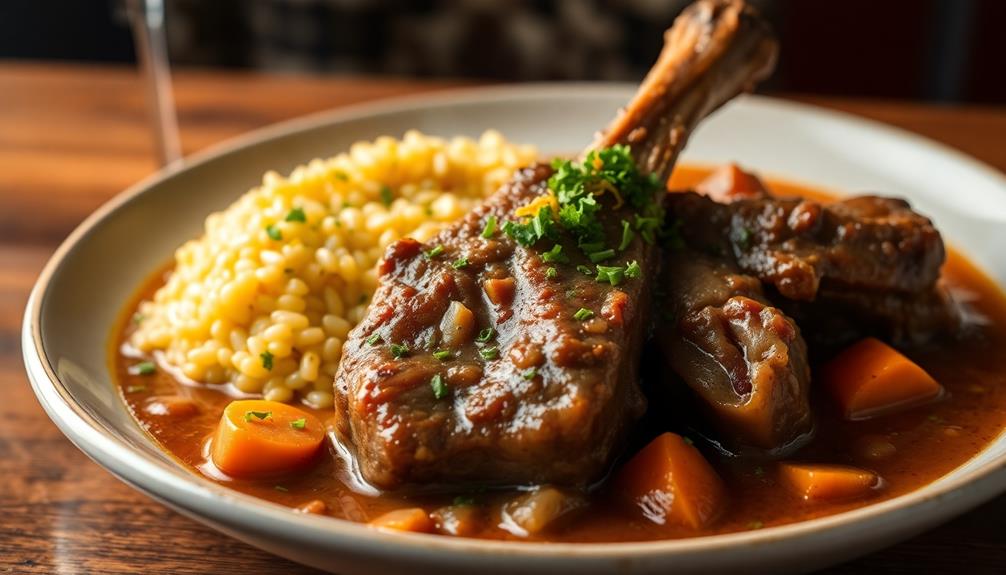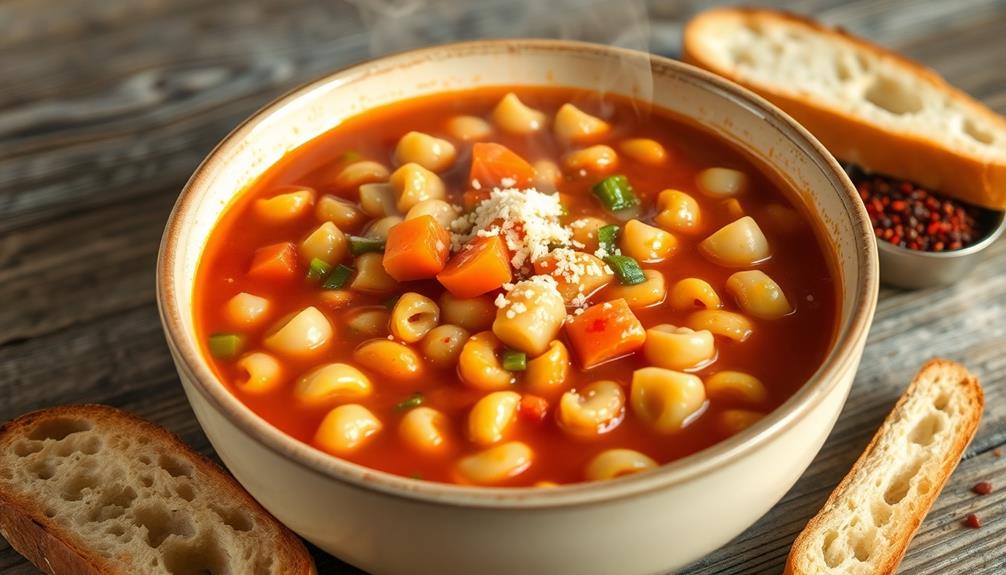Ossobuco alla Milanese is a delightful Italian dish that'll transport you to the heart of Milan! You'll savor the tender veal shanks, slowly braised in a rich tomato-based sauce, then garnished with the vibrant gremolata of lemon zest, parsley, and garlic. This classic recipe dates back centuries, showcasing the culinary pride of the Lombardy region. The long, slow cooking process breaks down the meat, yielding a melt-in-your-mouth texture. Serve it over creamy polenta or fluffy risotto for an authentic taste of Italy. Get ready to enjoy this timeless dish that's sure to delight your senses!
Key Takeaways
- Ossobuco alla Milanese is a classic Italian dish featuring tender veal shanks braised in a tomato-based sauce, originating from the Lombardy region.
- The long cooking process breaks down the connective tissue, yielding incredibly tender meat that is traditionally served with gremolata, a mixture of lemon zest, parsley, and garlic.
- Ossobuco is considered an integral part of Italian culinary heritage and is often enjoyed with risotto alla Milanese, showcasing the gastronomic pride of Milan.
- The dish's name "ossobuco" translates to "hollow bone," referring to the veal shanks used as the primary protein source.
- Ossobuco alla Milanese is a symbol of communal dining, fostering connection through shared meals and representing the rich flavors and traditions of Italian cuisine.
History
Originating in the Lombardy region of Italy, ossobuco alla Milanese has a rich history that has stood the test of time. This beloved dish dates back to the 18th century, when Milanese chefs first crafted the savory, slow-cooked veal shanks.
Traditionally, the meat was simmered with vegetables, white wine, and aromatic herbs, creating a mouthwatering blend of flavors.
Over the centuries, ossobuco alla Milanese has become an integral part of Italian culinary heritage. Families would gather to enjoy this heartwarming meal, often accompanied by risotto alla Milanese, another regional specialty. Ossobuco alla Milanese originated in Lombardy, Italy, and has been passed down through generations, with each family adding its own unique twist to the dish. Similarly, risotto alla Milanese has a rich risotto history and origins, dating back to the 16th century, when saffron was first introduced to Italy. This creamy and aromatic rice dish has also become a beloved staple in Italian cuisine, often served alongside ossobuco alla Milanese to create a truly comforting and satisfying meal.
The dish's popularity has transcended borders, and it's now savored by food enthusiasts around the world.
Today, ossobuco alla Milanese remains a cherished symbol of Milan's gastronomic pride. Whether served in cozy trattorias or elegant restaurants, this timeless dish continues to bring joy and comfort to those who savor its rich, tender goodness.
Recipe
Ossobuco alla Milanese is a classic Italian dish that originated in Milan, Italy. It features tender veal shanks slowly braised in a flavorful tomato-based sauce, often garnished with gremolata, a zesty mixture of lemon zest, parsley, and garlic.
The dish's name, "ossobuco," translates to "hollow bone," referring to the cross-cut veal shanks that are the star of the show. The long, slow cooking process breaks down the connective tissue, resulting in meat that falls off the bone effortlessly.
Ingredients:
- 4 veal shanks, about 1-inch thick
- 1/4 cup all-purpose flour
- 3 tablespoons olive oil
- 1 large onion, diced
- 2 carrots, peeled and diced
- 2 celery stalks, diced
- 3 garlic cloves, minced
- 1 cup dry white wine
- 1 (14.5 oz) can crushed tomatoes
- 2 cups beef or chicken stock
- 1 bay leaf
- 2 sprigs fresh thyme
- Salt and freshly ground black pepper, to taste
Cooking Instructions:
In a large Dutch oven or heavy-bottomed pot, heat the olive oil over medium-high heat. Dredge the veal shanks in the flour, shaking off any excess. Brown the shanks on all sides, about 3-4 minutes per side, until they develop a nice golden-brown crust. Remove the shanks from the pot and set aside.
Reduce the heat to medium, and add the onion, carrots, and celery to the pot. Cook for about 5-7 minutes, stirring occasionally, until the vegetables are softened. Add the garlic and cook for an additional minute, until fragrant.
Pour in the white wine and use a wooden spoon to scrape up any browned bits from the bottom of the pot. Allow the wine to simmer for 2-3 minutes.
Return the veal shanks to the pot, and add the crushed tomatoes, stock, bay leaf, and thyme. Season with salt and pepper. Bring the mixture to a boil, then reduce the heat to low, cover, and simmer for 1.5-2 hours, or until the veal is very tender and falling off the bone.
Tips:
For the best flavor, use fresh, high-quality ingredients. Browning the veal shanks is an important step that adds depth of flavor to the dish.
Be patient during the long simmering process, as it's crucial for tenderizing the meat. Serve the ossobuco with the reduced braising liquid, and top with a generous amount of gremolata for a bright, zesty finish.
Cooking Steps
Season the veal shanks with salt and pepper.
Brown the shanks in a hot pan to get a nice sear.
Then, braise the shanks in the oven until they're fork-tender and the meat is falling off the bone.
Step 1. Season the Veal Shanks

Tender veal shanks form the foundation of this classic Milanese dish. First, you'll want to generously season the shanks with salt and pepper. Don't be shy – the more seasoning, the better! Sprinkle the salt and freshly ground black pepper all over the meat, making sure to coat every inch. This will help the flavors really shine through as the shanks cook.
Next, use your hands to gently rub the seasoning into the meat, getting it deep into the crevices. This helps the flavors permeate the veal, resulting in a mouthwatering dish.
You can even add a pinch of dried herbs, like rosemary or thyme, for an extra aromatic touch. Just remember, a little goes a long way!
Once the shanks are perfectly seasoned, you're ready to move on to the next step in creating this delectable Ossobuco alla Milanese.
Step 2. Brown the Veal Shanks
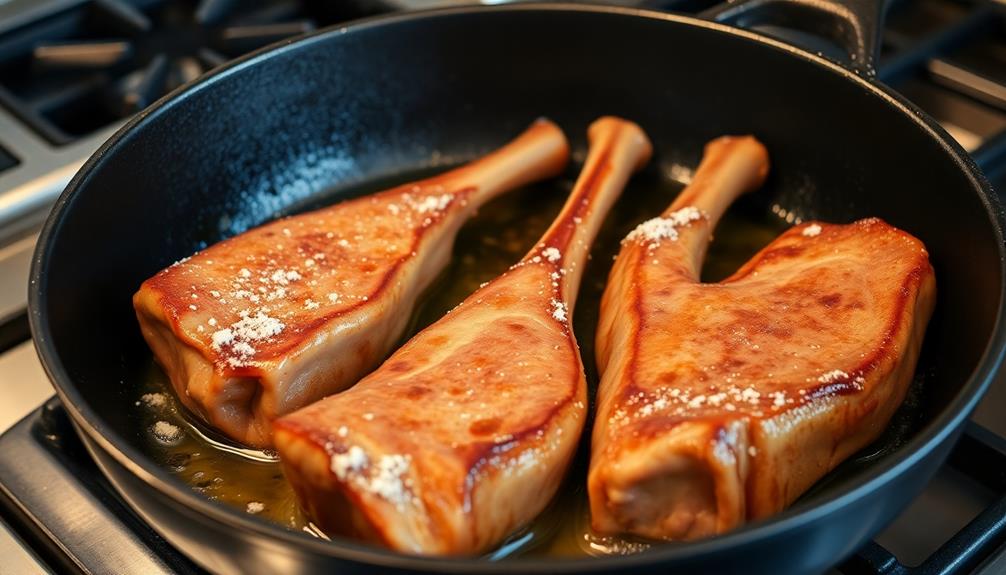
Next, you'll want to sear the seasoned veal shanks in a large, heavy-bottomed pan or Dutch oven over medium-high heat.
The key is to get a nice, golden-brown crust on the meat, which will add tons of flavor to the final dish.
Carefully place the shanks in the hot pan, making sure not to overcrowd them.
You'll want to let them sizzle and brown for about 3-4 minutes per side, turning them gently with tongs to ensure even browning.
The aroma as the meat cooks will fill your kitchen and have your mouth watering in no time!
Once the shanks are beautifully browned, remove them from the pan and set them aside.
You'll use the flavorful browned bits left in the pan to start building your ossobuco sauce.
Get ready for the next step – adding the aromatic vegetables!
Step 3. Braise the Veal Shanks
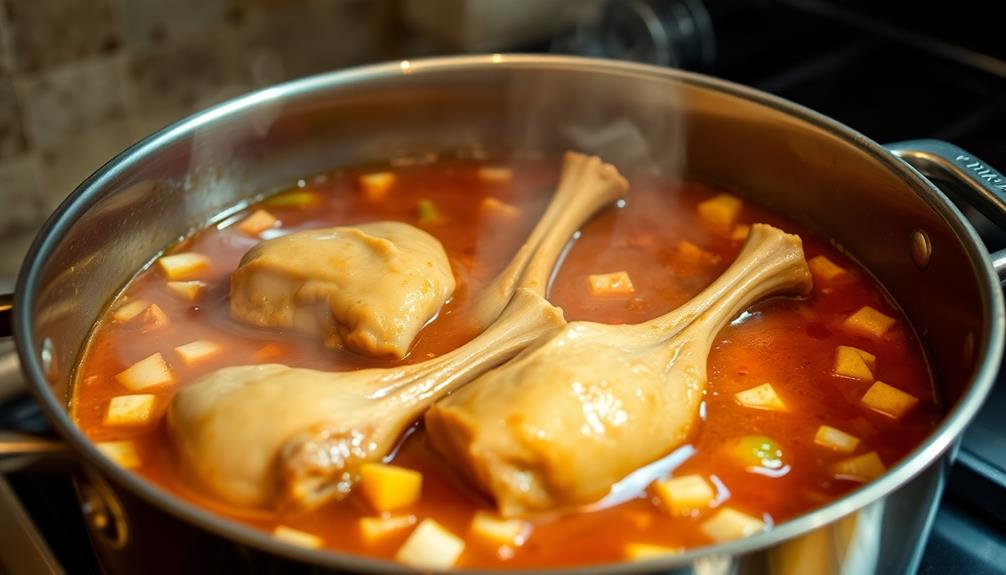
With the veal shanks beautifully browned, it's time to braise them to tender perfection.
Grab a large Dutch oven or heavy-bottomed pot and add a few tablespoons of olive oil. Gently place the shanks into the hot oil and let them sizzle for a minute or two, turning them to get an even sear on all sides.
Next, add the aromatic vegetables – onions, carrots, and celery – and sauté until they start to soften.
Sprinkle in a bit of flour to create a roux, then pour in the white wine and scrape up any browned bits from the bottom of the pot.
Let the wine simmer until it's reduced by half.
Step 4. Add Vegetables and Stock
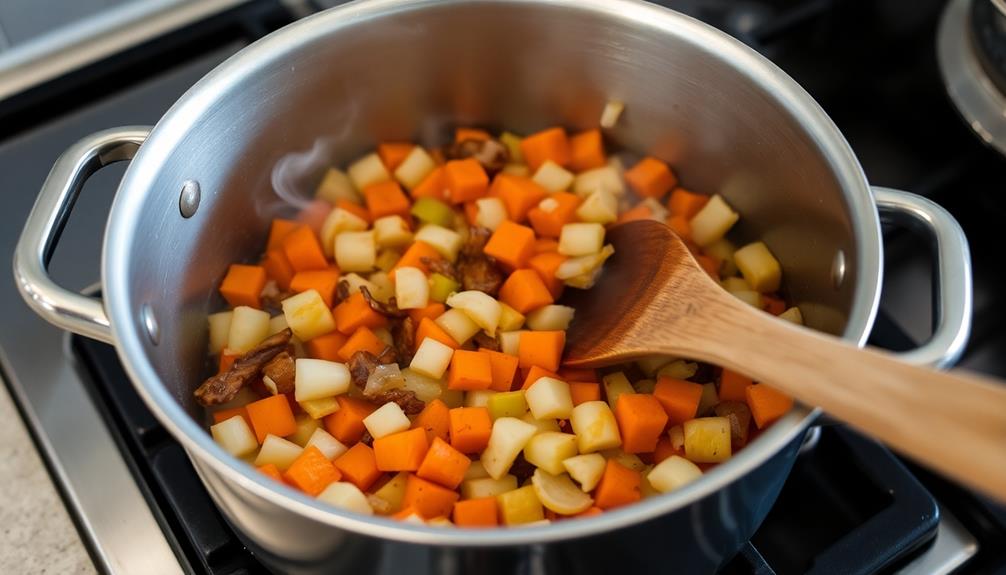
Now that the veal shanks are beautifully browned, it's time to add the aromatic vegetables and stock to the braising liquid.
First, toss in the chopped onions, carrots, and celery. These veggies will add incredible flavor as they soak up all the tasty bits from the pan.
Next, pour in the warm beef stock, making sure to scrape up any browned bits on the bottom of the pot. This will create a rich, flavorful braising liquid that will transform the veal shanks into tender, fall-off-the-bone perfection.
Bring the mixture to a gentle simmer, then cover the pot with a tight-fitting lid.
Let the ossobuco braise for about 1 1/2 to 2 hours, or until the meat is incredibly tender.
Every so often, check on the dish and baste the veal shanks with the delicious braising liquid. The aroma wafting through your kitchen will have your mouth watering in anticipation!
Step 5. Reduce Heat, Simmer Until Tender
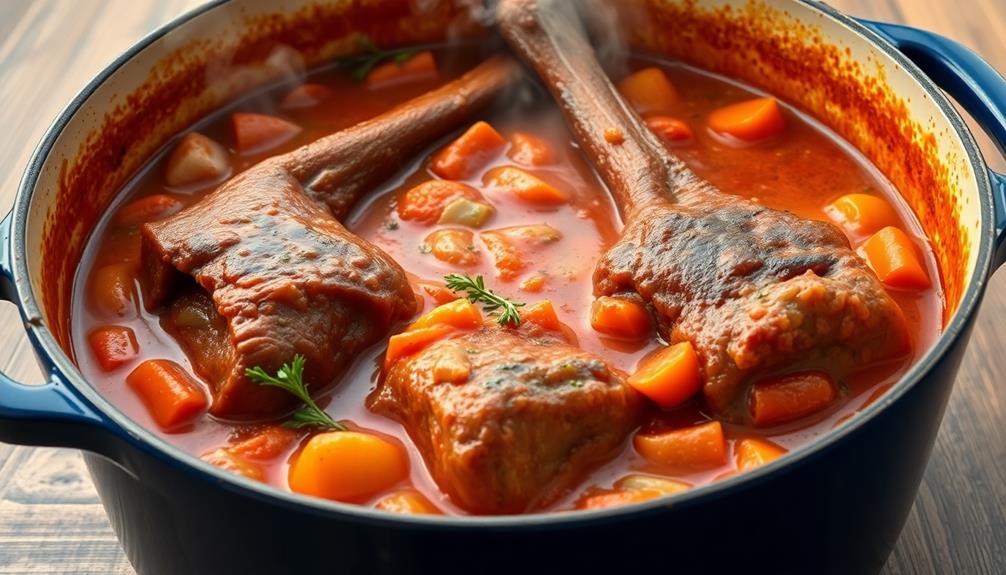
Once the veggies and stock have been added, reduce the heat to a gentle simmer. This will allow the flavors to meld together beautifully.
As the ossobuco simmers, the meat will become meltingly tender, falling off the bone with ease. Keep a watchful eye, stirring occasionally to prevent sticking. The aroma filling your kitchen will have your mouth watering in anticipation!
After 45 minutes to an hour, the ossobuco should be fork-tender. The sauce will have thickened, coating the meat in a rich, savory glaze.
Don't be tempted to rush – low and slow is the key to achieving that signature Milanese texture. When the meat is fall-off-the-bone perfect, it's time to serve.
Ladle the ossobuco over creamy polenta or buttery mashed potatoes, and prepare to be transported to the heart of Milan with every bite. Buon appetito!
Final Thoughts
Ultimately, ossobuco alla Milanese is a dish that showcases the rich flavors and tender texture of veal shanks. When you take that first bite, you'll be transported to the bustling streets of Milan with each mouthful. The slow-simmered meat practically falls off the bone, melting in your mouth.
And the gremolata – that vibrant blend of garlic, parsley, and lemon zest – adds a bright, aromatic note that ties the whole dish together.
What really makes this dish special is how the ingredients come together in perfect harmony. The veal, the broth, the wine – they all mingle and meld, creating a symphony of flavors that will have your taste buds singing.
Plus, it's a great dish to enjoy with family and friends, sharing stories and laughter over a hearty, comforting meal.
Frequently Asked Questions
How Can I Make Ossobuco Alla Milanese Vegetarian?
To make a vegetarian version, you can substitute the veal shanks with hearty vegetables like mushrooms, eggplant, or zucchini. Braise them in a flavorful tomato-based sauce, and finish with gremolata for the classic Milanese touch.
What Wine Pairs Best With This Dish?
When pairing wine with this dish, you'll want a bold, full-bodied red that can stand up to the rich, savory flavors. Consider a Barolo, Chianti, or Sangiovese – the tannins and acidity will complement the dish beautifully.
Can I Use a Slow Cooker to Make Ossobuco?
You can absolutely use a slow cooker to make ossobuco. The slow, gentle cooking method helps break down the tough meat and infuses it with rich, flavorful sauce. Just be sure to sear the meat beforehand for best results.
How Long Can Leftover Ossobuco Be Stored?
Leftover ossobuco can be stored in the refrigerator for 3-4 days or in the freezer for 2-3 months. Make sure to store it in an airtight container to maintain freshness and prevent freezer burn.
Is There a Gluten-Free Version of This Recipe?
There is indeed a gluten-free version of this recipe. You can substitute the breadcrumbs with gluten-free alternatives like almond flour or ground nuts to create a delicious and safe meal for those with gluten sensitivities.
